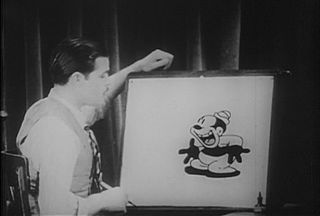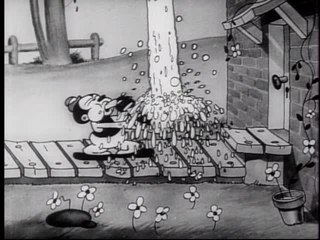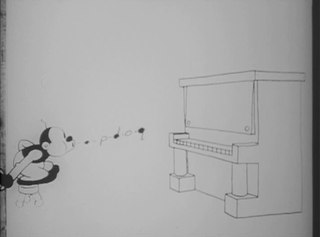Related Research Articles

Looney Tunes is an American animated franchise produced and distributed by Warner Bros. It began as a series of short films that originally ran from 1930 to 1969, concurrently with its partner series Merrie Melodies, during the golden age of American animation. Following a revival in the late 1970s, new shorts were released as recently as 2014. The two series introduced a large cast of characters, including Bugs Bunny, Daffy Duck, and Porky Pig. The term Looney Tunes has since been expanded to also refer to the characters themselves.
Silly Symphony is an American animated series of 75 musical short films produced by Walt Disney Productions from 1929 to 1939. As the series name implies, the Silly Symphonies were originally intended as whimsical accompaniments to pieces of music. As such, the films usually did not feature continuing characters, unlike the Mickey Mouse shorts produced by Disney at the same time. The series is notable for its innovation with Technicolor and the multiplane motion picture camera, as well as its introduction of the character Donald Duck making his first appearance in the Silly Symphony cartoon The Wise Little Hen in 1934. Seven shorts won the Academy Award for Best Animated Short Film.

The golden age of American animation was a period in the history of U.S. animation that began with the popularization of sound synchronized cartoons in 1928 and gradually ended in the 1960s when theatrical animated shorts started to lose popularity to the newer medium of television. Animated media from after the golden age, especially on television, were produced on cheaper budgets and with more limited techniques between the 1960s and 1980s.

Bosko is an animated cartoon character created by animators Hugh Harman and Rudolf Ising. Bosko was the first recurring character in Leon Schlesinger's cartoon series and was the star of thirty-nine Looney Tunes shorts released by Warner Bros. He was voiced by Carman Maxwell, Johnny Murray, and Billie "Buckwheat" Thomas during the 1920s and 1930s and once by Don Messick during the 1990s.

Isadore "Friz" Freleng, credited as I. Freleng early in his career, was an American animator, cartoonist, director, producer, and composer known for his work at Warner Bros. Cartoons on the Looney Tunes and Merrie Melodies series of cartoons from the 1930s to the early 1960s. In total he created more than 300 cartoons.

Hugh Harman was an American animator. He was known for creating the Warner Bros. Cartoons and MGM Cartoons studios and his collaboration with Rudolf Ising during the Golden Age of American animation.
Hugh Harman and Rudolf Ising were an American animation team and company known for founding the Warner Bros. and Metro-Goldwyn-Mayer animation studios. In 1929, the studio was founded under the name Harman-Ising Productions, producing Looney Tunes and Merrie Melodies for Leon Schlesinger from 1930 to 1933. From 1934 to 1938, Harman-Ising produced the Happy Harmonies series, with William Hanna as their employee.

Rudolf Carl Ising was an American animator best known for collaborating with Hugh Harman to establish the Warner Bros. and MGM Cartoon studios during the early years of the golden age of American animation. In 1940, Ising produced William Hanna and Joseph Barbera's first cartoon, Puss Gets the Boot, a cartoon featuring characters later known as Tom and Jerry.

Bosko the Doughboy is a one-reel 1931 short subject animated cartoon, part of the Bosko series. It was directed by Hugh Harman, and first released on October 17, 1931 as part of the Looney Tunes series from Harman-Ising Productions and distributed by Warner Bros.

Foxy is an animated cartoon character featured in the first three animated shorts in the Merrie Melodies series, all distributed by Warner Bros. in 1931. He was the creation of animator Rudolf Ising, who had worked for Walt Disney in the 1920s.

Sinkin' in the Bathtub is the first Warner Bros. theatrical cartoon short as well as the first of the Looney Tunes series. The short debuted in April 1930, at the Warner Bros. Theater in Hollywood. The cartoon features Bosko, and the title is a pun on the 1929 song Singin' in the Bathtub. The film was erroneously copyrighted under the same title as the 1929 song. It is now in the public domain in the United States as the copyright was not renewed.

Bosko, the Talk-Ink Kid is a 1929 live-action/animated short film produced to sell a series of Bosko cartoons. The film was never released to theaters, and therefore not seen by a wide audience until 2000 on Cartoon Network's television special Toonheads: The Lost Cartoons. The film was produced on May 29, 1929 and directed by Hugh Harman and Rudolf Ising.
Willie Whopper is an animated cartoon character created by American animator Ub Iwerks. The Whopper series was the second from the Iwerks Studio to be produced by Pat Powers and distributed through Metro-Goldwyn-Mayer. 14 shorts were produced in 1933 to 1934.

Barney Bear is an American series of animated cartoon short subjects produced by MGM Cartoons. The title character is an anthropomorphic cartoon character, a sluggish, sleepy bear who often is in pursuit of nothing except for peace and quiet. 26 cartoons were produced between 1939 and 1954.

The Milky Way is a one-reel animated cartoon short subject, produced in Technicolor and released to theatres with the film The Captain Is a Lady in 1940 by Metro-Goldwyn-Mayer. The short explores the adventures of the "three little kittens who lost their mittens", as they explore a dreamland where space is made up entirely of dairy products. The short won the 1940 Oscar for Best Animated Short Film, and was the first non-Disney film to do so. Other shorts nominated in 1940 included A Wild Hare by Warner Bros., introducing Bugs Bunny, and another MGM cartoon Puss Gets the Boot, with Jasper & Jinx, the prototype for Tom and Jerry. This makes 1940 the first time a Disney film wasn’t even nominated for the award. It was added as a bonus feature in the Marx Bros. DVD release of Go West (1940) and Warner Archive Blu-ray release of Broadway Melody of 1940 (1940).

The Metro-Goldwyn-Mayer cartoon studio was an American animation studio operated by Metro-Goldwyn-Mayer (MGM) during the Golden Age of American animation. Active from 1937 until 1957, the studio was responsible for producing animated shorts to accompany MGM feature films in Loew's Theaters, which included popular cartoon characters Tom, Jerry, Droopy, Butch, Spike, Tyke, and Barney Bear.
Owen Earl Duvall was an American artist and animator best known for his work on Disney comic strips in the early 1930s and for a handful of animated short films he directed at Warner Bros. Cartoons.
Bosko's Parlor Pranks is a 1934 Happy Harmonies cartoon produced by Hugh Harman and Rudolph Ising for Metro-Goldwyn-Mayer starring their character Bosko. It is the first Bosko cartoon produced in color, and the first made at MGM following the Harman-Ising studio ending its deal to produce Looney Tunes and Merrie Melodies for Warner Bros. and Leon Schlesinger. Warner Bros. would later own Happy Harmonies and the MGM cartoon studio through its Turner Entertainment Co. banner.
Paramount Pictures' Famous Studios produced three theatrical shorts featuring Casper the Friendly Ghost from the Noveltoon series: The Friendly Ghost in 1945, There's Good Boos To-Night in 1948, and A Haunting We Will Go in 1949. From 1950 to 1959, Paramount produced a series of Casper the Friendly Ghost theatrical shorts.

Milton Mouse is an animated character created at Fables Studios for Paul Terry's cartoon series Aesop's Fables. The character was introduced in 1921, and appeared in dozens of cartoon shorts through 1931. Milton often appeared alongside a girlfriend mouse, usually named Rita.
References
- ↑ Lenburg, Jeff (1999). The Encyclopedia of Animated Cartoons. Checkmark Books. p. 89. ISBN 0-8160-3831-7 . Retrieved 6 June 2020.
- ↑ "Happy Harmonies". www.bcdb.com, February 2, 2012
- ↑ Who's Who in Animated Cartoons: An International Guide to Film and Television's Award-Winning and Legendary Animators
- ↑ Webb, Graham (2011). The Animated Film Encyclopedia: A Complete Guide to American Shorts, Features and Sequences (1900-1999) (Second ed.). McFarland & Company Inc. p. 210. ISBN 978-0-7864-4985-9.
- ↑ Baxter, Devon (4 October 2017). "Harman-Ising's 'The Early Bird and the Worm' (1936)". Cartoon Research.
- ↑ Webb, Graham (2011). The Animated Film Encyclopedia: A Complete Guide to American Shorts, Features and Sequences (1900-1999) (Second ed.). McFarland & Company Inc. p. 101. ISBN 978-0-7864-4985-9.
- ↑ "LaserDisc Database - Happy Harmonies: MGM Cartoon Classics #1 [ML104688]".
- ↑ "LaserDisc Database - Happy Harmonies: MGM Cartoon Classics #1 [ML104688]".
- ↑ "MGM Buys Its Way Out of Pact for $225 Million". Los Angeles Times . 16 March 1999.